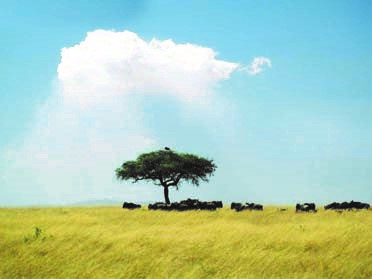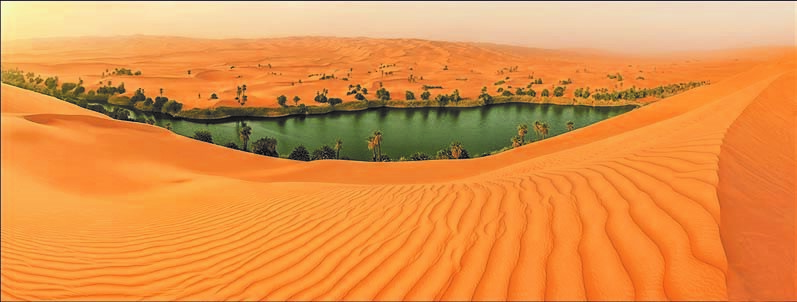natural areas. Africa - the mainland of the savannas
The geographical position, evenness of the relief contributed to the location of the geographical zones of Africa (equatorial, subequatorial, tropical and subtropical) and natural zones twice on both sides of the equator. As moisture decreases north and south of the equator, the vegetation cover becomes thinner and the vegetation more xerophytic.
In the north, there are many Mediterranean plant species. In the center and in the south, the most ancient representatives of the planet's vegetation have been preserved. Among flowering plants there are up to 9 thousand endemic species. Africa has a rich and diverse wildlife(see fig. 52 on p. 112). Nowhere in the world is there such an accumulation of large animals as in the African savannah. Elephants, giraffes, hippos, rhinos, buffaloes and other animals are found here. A characteristic feature of the animal world is the wealth of predators (lions, cheetahs, leopards, hyenas, hyena dogs, jackals, etc.) and ungulates (tens of species of antelopes). Among the birds there are large ones - ostriches, vultures, marabou, crowned cranes, bustards, hornbills, crocodiles live in the rivers.
Rice. 52. Typical representatives of the animal world of Africa: 1 - elephant; 2 - hippopotamus; 3 - giraffe; 4 - lion; 5 - zebra; 6 - marabou; 7 - gorilla; 8 - crocodile
In the natural zones of Africa there are many animals and plants that are not found on other continents. The African savannas are characterized by the baobab, whose trunk reaches 10 m in diameter, the doom palm, the umbrella acacia, the tallest animal in the world - the giraffe, lions, and the secretary bird. In the African equatorial forest (Gilea), the great apes gorilla and chimpanzee, the pygmy okapi giraffe live. In tropical deserts, there is a one-humped camel dromedary, a fennec fox, as well as the most poisonous mamba snake. Lemurs live only on the island of Madagascar.
Africa is the birthplace of a number of cultivated plants: oil palm, cola tree, coffee tree, castor beans, sesame, African millet, watermelons, many indoor flower plants - geraniums, aloe, gladioli, pelargonium, etc.
Zone of moist equatorial forests (giley) occupies 8% of the mainland - the basin of the Congo River and the coast of the Gulf of Guinea. The climate here is humid, equatorial, warm enough. Precipitation falls evenly, more than 2000 mm per year. The soils are red-yellow ferralitic, poor in organic matter. A sufficient amount of heat and moisture promotes the development of vegetation. In terms of the richness of species composition (about 25 thousand species) and area, the humid equatorial forests of Africa are second only to the humid equatorial forests of South America.
Forests form 4-5 tiers. Giant (up to 70 m) ficuses, oil and wine palms, ceiba, cola tree, and breadfruit grow in the upper tiers. In the lower tiers - bananas, ferns, Liberian coffee tree. Among the vines, the rubber-bearing liana landolphia and the rattan palm liana (up to 200 m in length) are interesting. This is the longest plant in the world. Red, iron, black (ebony) trees have valuable wood. There are many orchids and mosses in the forest.
There are few herbivores in the forests and fewer predators than in other natural areas. Of the ungulates, the pygmy okapi giraffe is characteristic, hiding in dense forest thickets, forest antelopes, water deer, buffalo, and hippopotamus are found. Predators are represented by wild cats, leopards, jackals. Of the rodents, the brush-tailed porcupine and broad-tailed flying squirrels are common. Monkeys, baboons, mandrills are numerous in the forests. Great apes are represented by 2-3 species of chimpanzees and gorillas.
The transition zone between equatorial forests and savannahs are subequatorial variable wet forests . They border the humid equatorial forests with a narrow strip. Vegetation gradually changes under the influence of a shortening of the wet period and an intensification of the dry season as one moves away from the equator. Gradually, the equatorial forest turns into a subequatorial, mixed, deciduous-evergreen forest on red ferrallitic soils. The annual precipitation decreases to 650-1300 mm, and the dry season increases to 1-3 months. A distinctive feature of these forests is the predominance of trees of the legume family. Trees up to 25 m high shed their leaves during the dry period, a grassy cover forms under them. Subequatorial forests are located on the northern edge of the equatorial moist forests and south of the equator in the Congo Basin.
 Rice. 53 African Savannah
Rice. 53 African Savannah
Savannah and woodlands occupy large expanses of Africa - the marginal uplifts of the Congo depression, the Sudanese plains, the East African plateau (about 40% of the territory). These are open grassy plains with groves or individual trees (Fig. 53). The zone of savannahs and light forests encircles moist and variable-humid forests from the Atlantic to the Indian Oceans and extends northward to 17¨ s. sh. and south to 20¨ S. sh. Savannahs have alternating wet and dry seasons. In the wet season, in the savannah, where the rainy season lasts up to 8-9 months, lush grasses grow up to 2 m high, sometimes up to 5 m. 53. In the African savannah (elephant grass). Among the continuous sea of cereals (cereal savanna), individual trees rise: baobabs, umbrella acacia, doum palms, oil palms. During the dry season, the grasses dry up, the leaves on the trees fall off, and the savannah becomes yellow-brown. Under the savannas, special types of soils are formed - red and red-brown soils.
Depending on the duration of the wet period, savannahs are wet or tall grass, typical or dry, and deserted.
Wet, or tall grass, savannahs have an insignificant dry period (about 3-4 months), and the annual precipitation is 1500-1000 mm. This is a transitional area from forest vegetation to typical savannah. The soils, like those of the subequatorial forests, are red ferralitic. Among the cereals - elephant grass, bearded man, from trees - baobab, acacia, carob, doom palm, cotton tree (ceiba). Evergreen forests are developed along the river valleys.
Typical savannahs are developed in areas with precipitation of 750-1000 mm, the dry period lasts 5-6 months. In the north, they stretch in a continuous strip from the Atlantic Ocean to the Ethiopian highlands. In the Southern Hemisphere they occupy the northern part of Angola. Characterized by baobabs, acacias, fan palms, shea tree, cereals are represented by bearded man. Soils are reddish brown.
Deserted savannas have less rainfall (up to 500 mm), the dry season lasts 7-9 months. They have a sparse grass cover, and acacias predominate among shrubs. These savannahs on red-brown soils stretch in a narrow strip from the coast of Mauritania to the Somali peninsula. In the south, they are widely developed in the Kalahari Basin. African savannahs are rich in food resources. There are more than 40 species of herbivorous ungulates here, antelopes are especially numerous (kudu, eland, pygmy antelopes). The largest of them is the wildebeest. Giraffes are preserved mainly in national parks. Zebras are common in the savannas. In some places they are domesticated and replace horses (not susceptible to tsetse bites). Herbivores are accompanied by numerous predators: lions, cheetahs, leopards, jackals, hyenas. Endangered animals include the black and white rhino and the African elephant. Birds are numerous: African ostriches, guinea fowls, francolins, marabou, weavers, secretary bird, lapwings, herons, pelicans. In terms of the number of species of flora and fauna per unit area, the savannahs of Africa are unmatched.
Savannas are relatively favorable for tropical farming. Significant areas of the savannas are plowed up, cotton, peanut, corn, tobacco, sorghum, and rice are cultivated.
North and south of the savannas are tropical semi-deserts and desert occupying 33% of the mainland. The desert zone is distinguished by a very low amount of precipitation (no more than 100 mm per year), and sparse xerophytic vegetation.
Semi-deserts are a transitional area between savannahs and tropical deserts, where the amount of precipitation does not exceed 250-300 mm. A narrow strip of semi-deserts in North Africa is subshrub-cereal (acacia, tamarisk, hard cereals). In South Africa, semi-deserts are developed in the interior of the Kalahari. The southern semi-deserts are characterized by succulents (aloe, spurge, wild watermelons). During the rainy period, irises, lilies, amaryllis bloom.
In North Africa, vast areas with precipitation up to 100 mm are occupied by the Sahara Desert, in South Africa the Namib Desert stretches in a narrow strip along the western coast, and in the south is the Kalahari Desert. According to vegetation, the deserts are grass-shrub, shrub and succulent.
The vegetation of the Sahara is represented by individual bunches of cereals and thorny shrubs. From cereals, wild millet is common, from shrubs and semi-shrubs - dwarf saxaul, camel thorn, acacia, jujube, euphorbia, ephedra. Solyanka and wormwood grow on saline soils. Around shotts - tamarisks. The southern deserts are characterized by succulent plants that resemble stones in appearance. In the Namib Desert, a kind of relic plant is common - the majestic velvichia (stump plant) - the lowest tree on Earth (up to 50 cm tall with long fleshy leaves 8-9 m long). There are aloe, euphorbia, wild watermelons, bush acacias.
Typical desert soils are gray soils. In those parts of the Sahara where groundwater is close to the surface of the earth, oases are formed (Fig. 54). All the economic activities of people are concentrated here; grapes, pomegranate, barley, millet, and wheat are grown. The main plant of the oases is the date palm.

Rice. 54. Oasis in the Sahara
The fauna of semi-deserts and deserts is poor. In the Sahara, among large animals, there are antelopes, wild cats, fennec foxes are found. Jerboas, gerbils, various reptiles, scorpions, phalanxes live in the sands.
natural area tropical rainforests found on the island of Madagascar and in the Dragon Mountains. It is characterized by ironwood, rubber-nosed and rosewood trees.
The transition zone between tropical deserts and subtropical evergreen forests and shrublands is subtropical semi-deserts and deserted steppes . In Africa, they occupy the interior regions of the Atlas and Cape mountains, the Karoo plateau, and the Libyan-Egyptian coast to 30°N. sh. The vegetation is very sparse. In North Africa, these are cereals, xerophytic trees, shrubs and shrubs, in South Africa - succulents, bulbous, tuberous plants.
Zone subtropical evergreen hardwood forests and bushes represented on the northern slopes of the Atlas Mountains and in the west of the Cape Mountains.
The forests of the Atlas Mountains form cork and holm oaks, Aleppo pine, Atlas cedar with an undergrowth of evergreen shrubs. Maquis is widespread - impenetrable thickets of hard-leaved evergreen shrubs and low trees (myrtle, oleander, pistachio, strawberry tree, laurel). Typical brown soils form here.
In the Cape Mountains, vegetation is represented by Cape olive, silver tree, African walnut.
In the extreme south-east of Africa, where there is a humid subtropical climate, lush mixed subtropical forests grow, represented by evergreen deciduous and coniferous species with an abundance of epiphytes. The zonal soils of subtropical forests are krasnozems.
The fauna of the northern subtropics is represented by European and African species. Red deer, mountain gazelle, mouflon, jungle cat, jackals, Algerian fox, wild rabbits, tailless narrow-nosed magot monkey live in the northern subtropical forests, canaries and eagles are widely represented among birds, and in the south - earthen wolf, jumping antelope, meerkats.
Bibliography
1. Geography grade 8. Textbook for the 8th grade of institutions of general secondary education with the Russian language of instruction / Edited by Professor P. S. Lopukh - Minsk "Narodnaya Asveta" 2014



